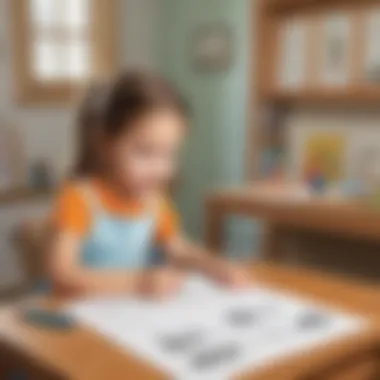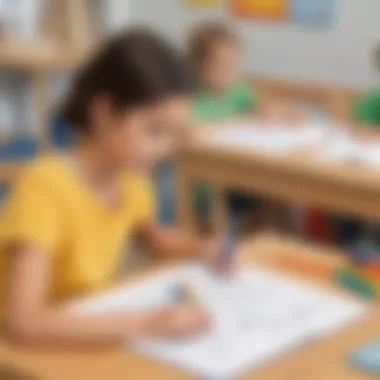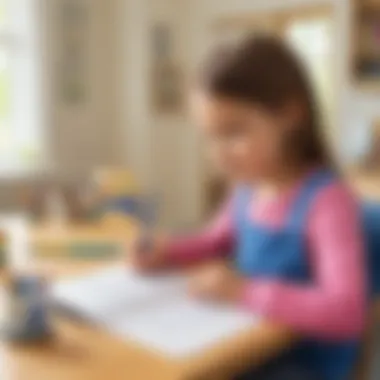Unlocking Early Literacy: Harnessing the Power of Kindergarten Worksheets for Teaching Sentence Writing


Fun Activities Ideas
Engaging kindergarten students in sentence writing can be a fun and stimulating process. Incorporating various indoor activities, such as creating sentence-building blocks or playing sentence formation games, allows children to enhance their language skills while enjoying the learning process. Outdoor adventures like nature scavenger hunts with sentence prompts can also provide an interactive and enriching experience. Arts and crafts activities, such as making sentence puzzles or storybook illustrations, can spark creativity and imagination in young learners. Science experiments involving creating sentences related to the experiment process can make learning grammar and writing enjoyable. Additionally, involving children in simple cooking and baking tasks where they write out recipe instructions can reinforce their sentence building skills in a practical and exciting way.
Educational Games
Integrating educational games into sentence writing practice can make learning more dynamic and engaging for kindergarten students. Math and logic games that involve forming sentences related to numbers or patterns can strengthen both language and mathematical skills simultaneously. Language and vocabulary games like word association or sentence bingo can help expand children's vocabulary and encourage sentence structuring. Exploring STEM activities where students write out explanations or hypotheses can foster critical thinking and analytical skills. History and geography puzzles requiring students to write sentences about historical figures or geographical landmarks can enhance their knowledge in a fun way. Interactive learning apps that guide students through sentence creation exercises can provide a hands-on and immersive learning experience for young writers.
Seasonal and Holiday Activities
Incorporating seasonal and holiday-themed activities into sentence writing can add a festive and creative element to the learning process. For instance, creating Valentine's Day crafts where children write love-themed sentences can promote expression and creativity. During Halloween, costume ideas can inspire writing spooky and imaginative sentences, fostering storytelling skills. Thanksgiving cooking projects involving writing out recipes or food descriptions can enhance descriptive language and writing proficiency. Decorating Christmas ornaments with sentences about holiday traditions can engage children in both crafting and language practice. Developing New Year's resolutions for kids with corresponding sentence writing tasks can encourage goal setting and self-expression through writing.
Parenting Tips and Resources
Providing parents with practical tips and resources to support sentence writing skills at home can greatly benefit a child's language and literacy development. Suggestions on how to encourage creativity through open-ended writing prompts or storytelling activities can nurture a child's imagination and love for writing. Setting up a playful learning environment that includes sentence-building games or writing stations can create a conducive space for language practice. Balancing screen time with hands-on play that involves writing sentences can promote active learning and reduce digital dependence. Building strong family bonds through collaborative writing projects or journaling activities can strengthen communication skills and create lasting memories. Motivating kids to stay active in writing by offering incentives or rewards for consistent sentence practice can instill a sense of achievement and progress.
Fun Facts and Trivia
Exploring fun facts and trivia related to various subjects can not only spark interest but also inspire creative sentence writing in kindergarten students. Delving into the wonders of the animal kingdom and having children write sentences describing different animals can deepen their understanding of biodiversity. Uncovering stories behind famous inventions and inventions can inspire children to craft innovative and imaginative sentences. Learning about historical events tailored for kids and having them write sentences summarizing key moments can make history more relatable and engaging. Exploring mythical creatures through sentence writing can fuel imagination and storytelling skills in young learners. Embarking on space adventures and discoveries through facts and articles can trigger curiosity and inspire children to create space-themed sentences.
Introduction
In the realm of education, the significance of teaching sentence writing to kindergarten students cannot be overstated. This section will delve into why focusing on sentence construction at such a young age is crucial for the development of language skills and literacy. By immersing children in the world of sentences early on, educators and parents pave the way for enhanced communication abilities, cognitive growth, and a solid foundation for future literacy endeavors.
Understanding the Importance of Sentence Writing in Kindergarten
Enhancing Communication Skills


Enhancing Communication Skills in kindergarteners through sentence writing plays a pivotal role in honing their ability to convey thoughts and emotions effectively. By engaging in structured sentence building activities, children learn to articulate their ideas with clarity and coherence, setting a strong foundation for successful communication in various settings. This approach fosters not only language proficiency but also boosts confidence levels as children see tangible results of their improved communication abilities.
Fostering Cognitive Development
Fostering Cognitive Development through sentence writing activities encourages critical thinking and problem-solving skills in young learners. By structuring sentences, children develop logical reasoning, sequencing abilities, and memory retention. These cognitive processes are crucial for academic success and overall intellectual growth, making sentence construction an indispensable tool for nurturing young minds.
Building a Strong Foundation for Literacy
Building a Strong Foundation for Literacy begins with sentence writing in kindergarten. By introducing children to the mechanics of language early on, educators lay the groundwork for future reading comprehension and writing proficiency. Understanding sentence structure, grammar rules, and syntax equips children with the essential skills needed to navigate the literacy landscape with confidence and fluency.
Overview of Kindergarten Worksheets
Types of Worksheets Available
Exploring the various Types of Worksheets Available for sentence writing in kindergarten opens up a world of diverse learning opportunities. From simple fill-in-the-blank exercises to creative story prompts, these worksheets cater to different learning styles and preferences, ensuring holistic development. By incorporating worksheets that cater to visual, auditory, and kinesthetic learners, educators can create a well-rounded learning experience that resonates with every child.
Benefits of Using Worksheets for Sentence Writing
The Benefits of Using Worksheets for Sentence Writing are manifold. Not only do these worksheets offer structured guidance for young writers, but they also provide a platform for practice and reinforcement of language skills. Through repetitive exercises, children enhance their vocabulary, grammar, and syntax, laying a solid foundation for future writing endeavors. Worksheets also promote independent learning and self-expression, fostering a sense of ownership and pride in one's writing abilities.
Effective Strategies for Teaching Sentence Writing
Interactive Writing Activities ## ating Sentence Building Blocks-In the context of teaching sentence writing to kindergarten students, creating sentence building blocks is a vital strategy aimed at developing fundamental writing skills from an early age. This activity involves breaking down sentences into basic components such as subjects, verbs, and objects, allowing children to understand the structure of a sentence. By engaging in this hands-on exercise, students grasp the essential elements of sentence construction, enhancing their linguistic abilities. Creating sentence building blocks fosters a deeper comprehension of grammar rules and sentence formation, laying a strong foundation for advanced writing skills. This method not only improves writing proficiency but also cultivates critical thinking and problem-solving skills in young learners.### Ut ng Picture Prompts-Another effective strategy for teaching sentence writing is utilizing picture prompts to stimulate creative thinking and language development in kindergarten students. By presenting visual cues or images, educators can prompt children to construct sentences based on their observations or interpretations. This method encourages students to express their ideas using written language, enhancing both vocabulary and sentence structure. Picture prompts also serve as a valuable tool for enhancing imagination and narrative skills, allowing students to connect visual stimuli with written communication. Integrating picture prompts into writing activities provides a multisensory approach to language learning, catering to diverse learning styles and promoting engagement in the writing process.
Creating Engaging Kindergarten Worksheets
In this segment of the article, we delve into the critical facet of Crafting Enticing Kindergarten Worksheets. This section aims to underline the paramount importance of worksheet design tailored for kindergartners. By focusing on Creating Engaging Kindergarten Worksheets, educators and parents can harness the power of innovative learning tools to captivate young minds. The significance of this topic lies in its ability to foster creativity, enhance critical thinking skills, and promote a love for writing from an early age.
Incorporating Themes and Storytelling


Narrative Writing Worksheets
Narrative Writing Worksheets play a pivotal role in nurturing young learners' storytelling abilities. They offer a structured framework for children to develop their narrative skills, encouraging them to craft compelling stories with a beginning, middle, and end. The key characteristic of Narrative Writing Worksheets is their capacity to spark imagination and creativity in young students. By incorporating storytelling elements, these worksheets provide a well-rounded approach to sentence writing, enabling children to express their thoughts cohesively. The unique feature of Narrative Writing Worksheets lies in their ability to enhance language proficiency while honing narrative construction skills, making them a valuable asset in facilitating holistic language development.
Character Development Exercises
Character Development Exercises aim to enrich students' understanding of character formation within narratives. These exercises focus on character traits, emotions, and interactions to deepen children's engagement with storytelling. The key characteristic of Character Development Exercises is their emphasis on fostering empathy and character depth in young writers. By prompting students to create well-rounded characters, these exercises enable them to explore diverse perspectives and enhance their storytelling prowess. The unique feature of Character Development Exercises lies in their capacity to cultivate empathy, emotional intelligence, and character complexity in young learners, making them a valuable addition to fostering comprehensive writing skills.
Utilizing Visual Aids and Colorful Illustrations
Drawing Inspiration from Images
Drawing Inspiration from Images amplifies the visual aspect of kindergarten writing activities. By incorporating visually stimulating prompts, educators can ignite children's imagination and inspire unique storylines. The key characteristic of Drawing Inspiration from Images is its ability to evoke creativity and enhance visual literacy skills in young learners. This approach offers a multi-dimensional perspective to sentence writing, allowing children to derive inspiration from diverse visual cues. The unique feature of Drawing Inspiration from Images lies in its capacity to enhance visual storytelling skills and cultivate a deeper appreciation for visual elements in writing.
Color-Coding Sentences for Clarity
Color-Coding Sentences for Clarity aims to enhance comprehension and organization in children's writing. By assigning specific colors to different parts of a sentence, educators promote visual clarity and structure in sentence formation. The key characteristic of Color-Coding Sentences for Clarity is its effectiveness in reinforcing grammar rules and sentence structure while improving visual presentation. This method not only simplifies sentence construction but also aids in the understanding of sentence components. The unique feature of Color-Coding Sentences for Clarity lies in its ability to foster visual organization and aid in sentence comprehension, making it a valuable tool for developing writing skills.
Integrating Multisensory Learning Techniques
Kinesthetic Writing Activities
Kinesthetic Writing Activities engage children in hands-on writing experiences that involve movement and physical interaction. These activities amplify kinesthetic learning, promoting muscle memory and tactile engagement in sentence construction. The key characteristic of Kinesthetic Writing Activities is their kinesthetic approach to writing, which enhances motor skills and reinforces learning through physical movement. By incorporating kinesthetic elements, educators can cater to varied learning styles and enhance children's understanding of sentence structure and formation. The unique feature of Kinesthetic Writing Activities lies in their ability to stimulate physical and cognitive connections, fostering a dynamic learning environment that intertwines movement with literacy development.
Sensory-Inclusive Worksheets
Sensory-Inclusive Worksheets are designed to accommodate diverse sensory needs and preferences in young learners. These worksheets incorporate sensory elements such as textures, scents, and sounds to create a sensory-rich writing experience. The key characteristic of Sensory-Inclusive Worksheets is their inclusive design, which caters to children with sensory sensitivities or preferences. By offering a multisensory approach to writing, these worksheets promote sensory exploration and enhance engagement in sentence writing tasks. The unique feature of Sensory-Inclusive Worksheets lies in their ability to provide a sensory-friendly writing environment that encourages creativity, concentration, and immersive learning experiences.
Assessment and Feedback Strategies


In the realm of kindergarten education, the Assessment and Feedback Strategies section plays a fundamental role in gauging the progress and understanding of young learners. It offers a comprehensive view of students' development and helps educators tailor their teaching methods effectively. By assessing students' sentence writing abilities, teachers can identify strengths and areas needing improvement, guiding them towards language proficiency. Feedback provided through this process enables personalized attention to each child, fostering a supportive learning environment that nurtures academic growth. Through structured assessment and constructive feedback, educators can optimize instructional strategies, leading to enhanced language skills and literacy competence among kindergarten students.
Evaluating Sentence Structure and Grammar
Analyzing Sentence Complexity
When delving into Analyzing Sentence Complexity, the focus is on understanding the intricacies of sentence structures in young learners' writing. This aspect seeks to evaluate the sophistication of sentences created by kindergarteners, considering factors like sentence length, variety of vocabulary used, and the presence of conjunctions and transitions. Analyzing Sentence Complexity contributes significantly to the goal of assessing students' writing proficiency and language development. By dissecting the complexity of sentences, educators gain insights into children's cognitive abilities and linguistic progress over time. This method's key characteristic lies in its ability to provide a quantitative and qualitative measurement of students' writing skills, allowing for tailored instruction to meet individual learning needs. Despite its minor limitations in purely assessing creativity or content depth, Analyzing Sentence Complexity remains a valuable tool in evaluating sentence construction in kindergarten writing exercises.
Checking for Punctuation and Capitalization
The aspect of Checking for Punctuation and Capitalization holds paramount importance in ensuring the fundamental principles of writing are instilled in young students. This element contributes significantly to refining students' grammatical accuracy and adherence to language rules. Highlighting the correctness of punctuation marks and capitalization in sentences aids in cultivating proper writing habits from an early age. It reinforces the significance of clarity and structure in written expression, laying a strong foundation for future language proficiency. The key characteristic of this aspect is its emphasis on precision and attention to detail, promoting accurate communication through written language. While it may seem rigid in its guidelines, Checking for Punctuation and Capitalization proves to be a crucial component in enhancing students' grasp of language mechanics within the context of kindergarten writing assessments.
Providing Constructive Feedback
Encouraging Revision and Improvement
Encouraging Revision and Improvement stands as a pivotal aspect in the feedback process, aiming to empower students to refine their writing skills continuously. This strategy motivates learners to revisit their work, identify areas for enhancement, and implement constructive changes to strengthen their writing. By emphasizing the value of revision, educators instill a growth mindset in young writers, nurturing resilience and perseverance in the face of challenges. The key characteristic of this approach lies in its capacity to promote self-reflection and refinement, fostering iterative learning experiences that lead to skill development and improvement over time. While it requires patience and guidance from teachers, Encouraging Revision and Improvement cultivates a culture of continuous learning and advancement among kindergarten students engaging in writing exercises.
Offering Positive Reinforcement
In the domain of providing feedback, Offering Positive Reinforcement serves as a powerful tool in reinforcing desired behaviors and achievements in young learners. This aspect focuses on acknowledging and celebrating students' progress, creating a positive learning environment that motivates ongoing efforts and engagement. By praising students for their writing accomplishments, educators enhance self-esteem and confidence, encouraging continual growth and development. The key characteristic of Offering Positive Reinforcement lies in its ability to nurture intrinsic motivation and a sense of accomplishment in young writers, fueling their enthusiasm for learning and improvement. While it requires a delicate balance with constructive criticism, Offering Positive Reinforcement proves indispensable in bolstering students' morale and enthusiasm for engaging in writing activities within the realm of kindergarten education.
Conclusion
In the realm of early childhood education, the significance of teaching kindergarten students to write sentences through engaging worksheets cannot be overstated. This article has delved deep into the fundamental aspects of sentence formation in young learners, highlighting the crucial role it plays in language development and literacy acquisition. By providing a structured approach to sentence writing, educators and parents can lay a solid foundation for academic success and effective communication skills. The utilization of worksheets as a tool for enhancing writing abilities at a young age sets the stage for comprehensive learning experiences that nurture critical thinking and creative expression.
Empowering Young Writers Through Practice
Nurturing a Love for Language
Delving into the core of nurturing a love for language among kindergarten students reveals a key tactic in fostering a lifelong appreciation for communication and literacy. By instilling a passion for language early on, children are encouraged to engage actively in linguistic activities, thereby honing their writing skills and expressive capabilities. By fostering an environment where language is celebrated and explored, young learners are motivated to express themselves with confidence and creativity, laying the groundwork for future academic success and personal fulfillment.
Preparing Kindergarteners for Reading Success
Preparing kindergarteners for reading success sets the trajectory for their academic journey towards proficiency in literacy. By equipping young learners with the necessary tools and skills to comprehend written text, educators and parents ensure that children are well-prepared to navigate the complexities of language and literature. Through targeted strategies and engaging activities, kindergarteners can develop a strong foundation in reading, setting the stage for lifelong learning and a deep appreciation for the written word. By focusing on reading success early on, students are empowered to explore new worlds, ideas, and perspectives through the written language, instilling a love for reading that transcends the classroom setting and enriches their lives.



